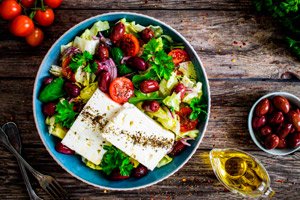
All iLive content is medically reviewed or fact checked to ensure as much factual accuracy as possible.
We have strict sourcing guidelines and only link to reputable media sites, academic research institutions and, whenever possible, medically peer reviewed studies. Note that the numbers in parentheses ([1], [2], etc.) are clickable links to these studies.
If you feel that any of our content is inaccurate, out-of-date, or otherwise questionable, please select it and press Ctrl + Enter.
Mediterranean Diet and the Prostate: Men with BPH Have Better Urine Flow and Fewer Symptoms
Last reviewed: 18.08.2025
 ">
">In a prospective study of 400 men with lower urinary tract symptoms (LUTS) due to benign prostatic hyperplasia (BPH), higher adherence to the Mediterranean diet (MedDiet) was associated with better maximum urine flow (Qmax) and lower symptom severity (IPSS). No differences were found in mean flow, residual urine, or BMI. The study was published online July 6, 2025, in The Prostate.
Background
- LUTD and BPH are a common problem in middle-aged and elderly men. With age, the prevalence of BPH and related lower urinary tract symptoms (LUTS) increases sharply: meta-assessments give a lifetime prevalence of about 26% and a steady increase with age; global estimates indicate tens of millions of cases annually. This seriously affects the quality of life.
- Diet and LUTD are associated, but the "ideal" diet has not been defined. Reviews and population studies have found associations between overall diet quality and dietary patterns and the risk/severity of LUTD and BPH: "Western" patterns (high in saturated fat and red meat) are associated with worse outcomes, while "healthier" patterns are associated with better outcomes. However, evidence from intervention studies is limited.
- Why look at the Mediterranean diet (MedDiet). MedDiet has a good biological baseline: it reduces systemic inflammation and improves endothelial function, which may indirectly affect urodynamics and symptoms. This is supported by systematic reviews and meta-analyses.
- How symptoms and adherence to the diet are measured. The severity of LUTD in men is assessed in a standardized manner using the IPSS scale (7 symptoms + quality of life question), and adherence to the MedDiet is assessed using the short 14-item MEDAS questionnaire, validated in different populations.
- What gap does the new work fill? In a prospective study of 400 patients with LUTD/suspected BPH, groups with high and low MedDiet adherence (according to MEDAS) were compared and this was correlated with uroflowmetry (Qmax, etc.), residual urine volume, and IPSS. Conclusion: higher MedDiet adherence is associated with higher Qmax and fewer symptoms; no differences were found in mean flow and PVR. The authors suggest considering nutrition as part of a comprehensive non-pharmacological management of BPH.
What did they do?
- Who was included: 400 consecutive men with LNMP/suspected BPH.
- How they were divided: according to their commitment to MedDiet according to the MEDAS questionnaire - a group of adherents (AMD, n=193) and non-adherents (NAMD, n=207).
- What was measured: uroflowmetry (Qmax, mean flow), residual urine volume (PVR) and IPSS symptom scale.
- Statistics: comparison of groups and correlations of MEDAS with urinary parameters.
Main results
- Qmax was higher in MedDiet adherents: 13.87 ± 0.21 ml/s versus 12.08 ± 0.19 ml/s (p < 0.001).
- IPSS - lower (better): median 9 vs. 17 points (p < 0.001).
- No differences: mean flow, PVR and BMI.
- Correlations: MEDAS is positively associated with Qmax (r = 0.259; p < 0.001) and inversely associated with IPSS (r = −0.610; p < 0.001).
Why is this important?
LNMP in BPH significantly affects quality of life. In this context, diet is a safe non-drug lever that can be combined with drugs/observation. The authors emphasize: due to the observational design, causality is not proven, but the signal is encouraging.
What is the Mediterranean Diet (and how can it help)
The MedDiet is more vegetables, fruits, legumes, whole grains, nuts, olive oil, regular fish, and less red/processed meat, sugar, and ultra-processed foods. Possible mechanisms for improvement in BPH/LUTD include reduced inflammation and oxidative stress, better endothelial function, and lower visceral fat mass, which may be reflected in urine flow and complaints. (These are biologically plausible explanations, but they were not directly tested in this study.)
What does this mean for the patient?
- Discuss with your urologist: MedDiet can be implemented now as part of a comprehensive management of BPH - along with weight control, physical activity and, if indicated, alpha-blockers/5-alpha-reductase inhibitors.
- Focus on a daily “green” plate and olive oil; fish 1-2 times a week, nuts/legumes - regularly; limit sweets, sausages/bacon, fast food and excess alcohol.
Restrictions
- Observational study: it cannot be said that the diet itself “cured” the symptoms; hidden factors (compliance, activity, concomitant diseases) are possible.
- Nutritional assessment is based on a questionnaire; there is always a risk of systematic errors.
- Randomized trials are needed to confirm the effect and understand which components of the MedDiet are most important.
Source: İ. Dağlı et al. The Prostate, “The Mediterranean Diet and Benign Prostatic Hyperplasia: A Pathway to Improved Urinary Health” (online 6 July 2025; print - September 2025). https://doi.org/10.1002/pros.70009
